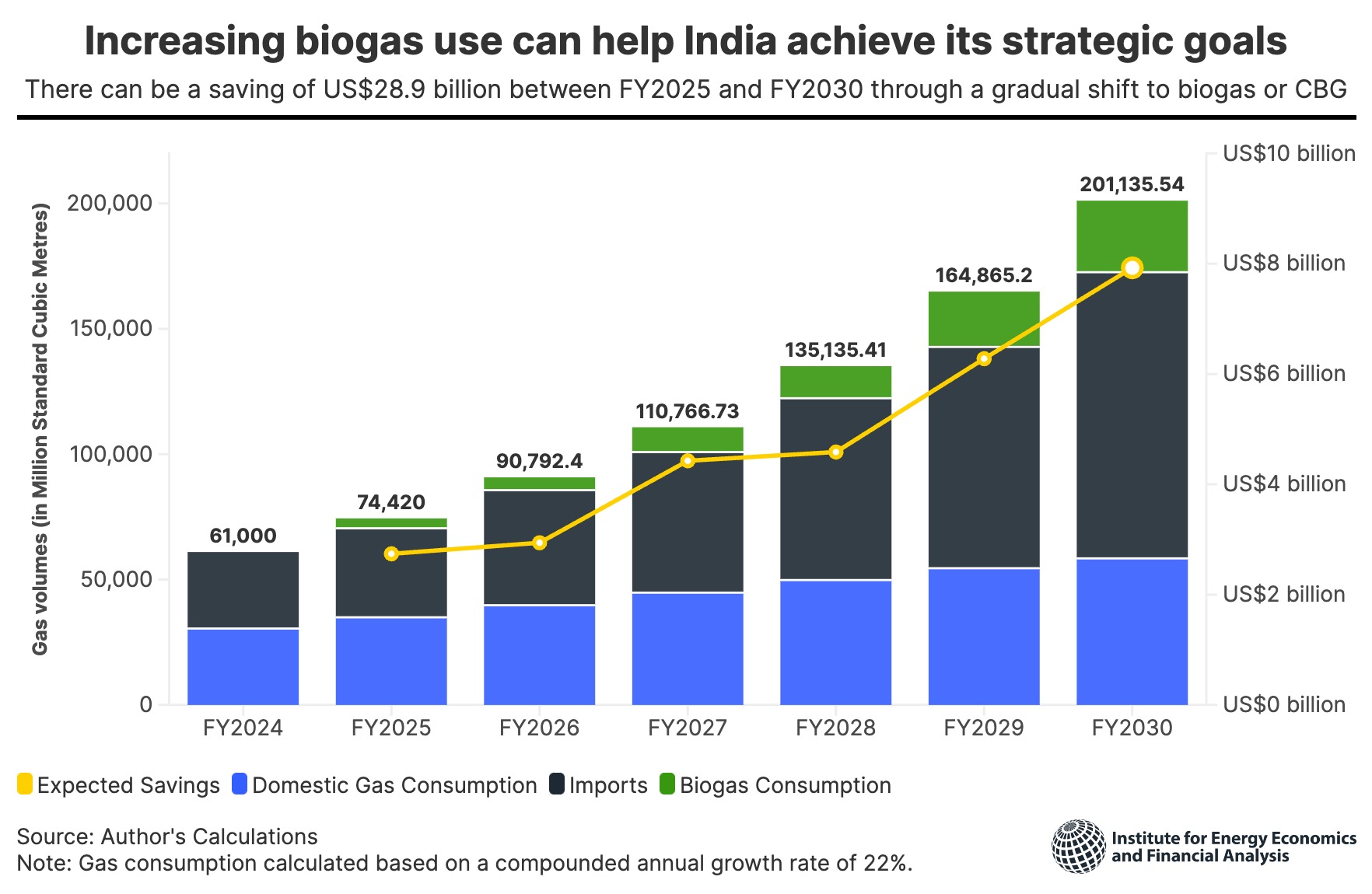Greater use of biogas can help India save US$29 billion in import bills between FY2025 and FY2030

The increased use of biogas in India can be a multi-pronged approach to solving issues like waste management, reducing greenhouse gas emissions and increasing renewable energy production. Most importantly, compressed biogas (CBG) can directly replace compressed natural gas (CNG).The increased use of biogas in India can be a multi-pronged approach to solving issues like waste management, reducing greenhouse gas emissions and increasing renewable energy production. Most importantly, compressed biogas (CBG) can directly replace compressed natural gas (CNG).
Key Takeaways:
India can cut its liquefied natural gas (LNG) import bill by approximately US$29 billion between the fiscal year (FY) 2025 and FY2030 if it manages to replace natural gas consumption with biogas and biomethane incrementally to 20%.
We expect the Indian government’s recent emphasis on biogas to augur well for the sector and help in having clear policy direction and robust market.
The recent revision of the CBG rate and plans to include a mandate on natural gas marketing companies for 5% CBG procurement, have reignited private sector interest.
Policymakers still need to fill gaps to create a comprehensive market system for the smooth operability of the biogas sector in India.
First generation biofuels, like ethanol, which use water-intensive crops like sugarcane and maize as feedstock run a huge risk of land use changes and negative climate impact. For biogas it must be ensured that only biomass and waste is used as feedstock and methane leakages are curbed.
Gradually increasing biogas and biomethane consumption to 20% by 2030 and replacing natural gas use can help India reduce its dependence on the fossil fuel and cut import bills by nearly US$29 billion, a new report by the Institute for Energy Economics and Financial Analysis (IEEFA) finds.
The report adds that increasing biogas projects will be multi-pronged environmental solution as it helps manage waste, reduce greenhouse gas (GHG) emissions and increase renewable energy production.
“Biogas can substitute natural gas or other fossil fuels with high emissions. Removing carbon dioxide (CO2) and other impurities like hydrogen sulfide can also upgrade its methane content to 90%, making it equivalent to natural gas in calorific value. This upgraded biogas, also known as biomethane, is a pipeline-ready gas and can be injected into the gas grids as a non-fossil gas,” says the report’s author Purva Jain, Energy Analyst, IEEFA.
“By undertaking the right production processes and plugging methane leakages in the production, upgradation and supply stages, biogas can offer India a cleaner alternative to its dependence on imported natural gas,” she adds.
Despite its benefits, biogas has failed to gain prominence in India. The report finds that this is because the sector lacked a comprehensive market ecosystem in terms of pricing and offtake, it did not have the right incentives and systems for obtaining clearances and permissions for setting up projects were complicated.
Most importantly, government support and financial assistance to the sector was till recently disaggregated among multiple ministries and departments.
“The government has started fix some of these gaps. In 2021, the government bundled different types of assistance under the National Bioenergy Scheme. Moreover, the introduction of the GOBARdhan (Galvanizing Organic Bio-Agro Resources Dhan) scheme as an umbrella initiative of the Government of India will help in this consolidation. It covers the entire gamut of schemes/policies promoting organic waste conversion to biogas or compressed biogas (CBG),” said Jain.
The report also highlights that recent policy initiatives, such as revising the CBG rate to reflect the increase in global gas prices and plans to include a mandate on natural gas marketing companies to 5% CBG procurement, have reignited private sector interest in CBG, including from the likes of Reliance Industries Limited and the Adani Group.
Still there is more to do on the government’s part if biogas is to reach its full potential in India.
“The government is showing clear intent to develop the biogas sector but it needs to do more. It needs to encourage increased investments and private participation in the sector. It can increase the market viability of CBG and biogas slurry, ensure increased financial access for developing biogas plants and encourage feedstock mapping to ensure the availability of inputs,” says Jain.
This will also help in ensuring that there is no use of energy crops for biogas as that can lead to indirect land use changes as seen in case of ethanol and biodiesel in Brazil which can have catastrophic impact on climate and environment through increased carbon emissions.
“A key step will be to ensure guaranteed offtake of CBG by different natural gas-using industries to expedite meeting decarbonisation goals. Introducing take-or-pay arrangements will be an important step in this direction,” she adds.
Read the report: Biogas: A Possible Solution for India’s Energy Security and Decarbonisation Goals
Media contact: Prionka Jha ([email protected]) Ph: +91 9818884854
Author contacts: Purva Jain ([email protected])
About IEEFA: The Institute for Energy Economics and Financial Analysis (IEEFA) examines issues related to energy markets, trends, and policies. The Institute’s mission is to accelerate the transition to a diverse, sustainable and profitable energy economy. (ieefa.org)











